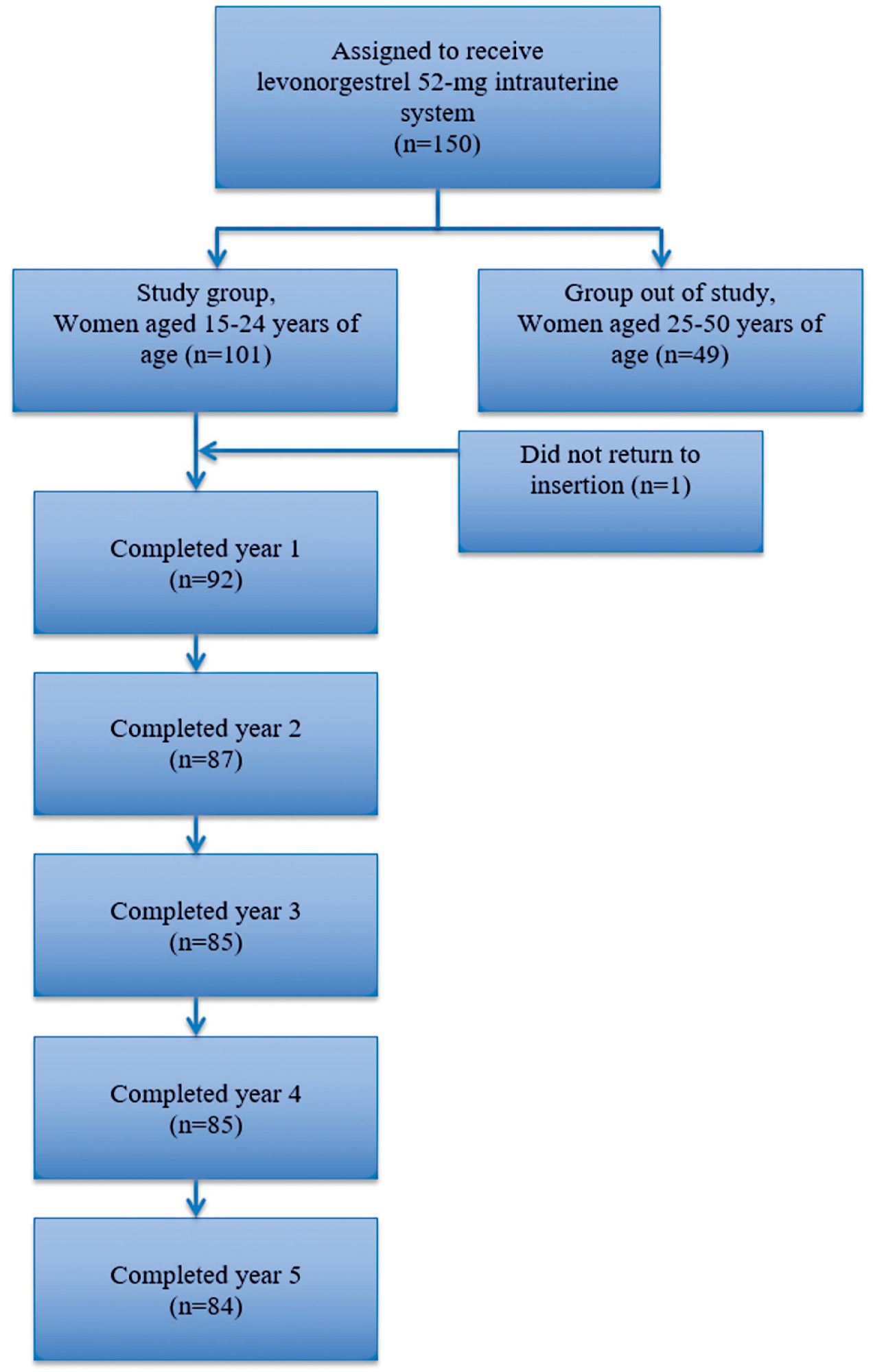-
Original Article/Contraception
Five-year Contraceptive Use of 52-mg Levonorgestrel Releasing Intrauterine System in Young Women, Menstrual Patterns, and New Contraceptive Choice
Revista Brasileira de Ginecologia e Obstetrícia. 2023;45(11):654-660
12-05-2023
Summary
Original Article/ContraceptionFive-year Contraceptive Use of 52-mg Levonorgestrel Releasing Intrauterine System in Young Women, Menstrual Patterns, and New Contraceptive Choice
Revista Brasileira de Ginecologia e Obstetrícia. 2023;45(11):654-660
12-05-2023Views123Abstract
Objective
To evaluate the continuation rates of the 52-mg levonorgestrel-releasing intrauterine system (LNG-IUS) during the first 5 years of use, reasons for its discontinuation, bleeding patterns, and new contraceptive choice after the 5th year, in adolescents and young women.
Methods
The present study was a 5-year prospective cohort conducted in a Family Planning Service of a tertiary hospital in Brazil. We selected 100 healthy women between 15 and 24 years old who used 52-mg LNG-IUS for contraception. The clinical follow-up of these women took place from June 2017 to December 2022. The study evaluated the continuation rates of the method, reasons for its discontinuation, bleeding patterns, and new contraceptive choice after the 5th year. Continuous data were reported as mean ± standard deviation (SD) and range (minimum-maximum). Categorical variables were described as percentages.
Results
The continuation rates of LNG-IUS were 89.1% (82/92), 82.9% (72/87), 75.3% (64/85), 70.5% (60/85), and 64.2% (54/84) in the 1st, 2nd, 3rd, 4th, and 5th years of use, respectively. The main reason for discontinuation was acne (11/30). Amenorrhea rates were 50, 54.1, 39, 35.7, and 51.8% at 12, 24, 36, 48, and 60 months, respectively. All patients who completed the study and needed contraception after the 5th year opted for long-acting contraceptive methods (LARC).
Conclusion
The LNG-IUS showed high continuation rates in adolescents and young women in the first 5 years of use. Most patients who completed the study chose a LARC method after the 5th year.
Key-words AdolescentsAmenorrheaContraceptionlevonorgestrel intrauterine systemlong-acting reversible contraceptionMenstruationSee more
-
Artigos Originais
Preference of Brazilian women regarding menstrual changes
Revista Brasileira de Ginecologia e Obstetrícia. 2007;29(2):74-79
05-02-2007
Summary
Artigos OriginaisPreference of Brazilian women regarding menstrual changes
Revista Brasileira de Ginecologia e Obstetrícia. 2007;29(2):74-79
05-02-2007DOI 10.1590/S0100-72032007000200003
Views69See morePURPOSE: to evaluate the association between women's menstrual experience and preferred changes in their menstrual cycles. METHODS: a cross-sectional study design was used. A total of 420 women were interviewed. Participants complied with the following criteria: age (18 to 20, 25 to 34 and 45 to 49 years); schooling (<8 years and >12 years); having menstruated during the three months previous to the study. Subjects were selected in the city of Campinas (SP), in nine private and seven public health services. For data collection, a questionnaire was prepared on the basis of the results of a previous pilot study that consisted of small groups. A data bank was prepared with the information registered in the questionnaires and the analysis was carried out with SAS, version 8.2. For the statistical analysis, the Pearson chi2 test and the Fisher exact test were used to evaluate the association between variables (p<0.05). RESULTS: most subjects preferred greater than once a month intervals between menstruations. There was an association of the typical menstrual intervals experienced by women (p=0.0248) and the degree of interference of menstruation with daily activities (p=0.048) with the preferred interval between menses. However, there was no association between preferred intervals by women and the following characteristics of pain: duration, intensity and use of medication. CONCLUSIONS: the results suggest that women would like intervals longer than one month or to never menstruate.


